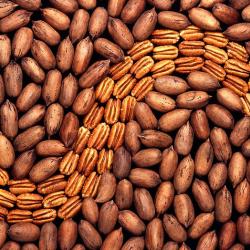Source Institutions
Source Institutions
Add to list Go to activity
Activity link broken? See if it's at the internet archive

In this activity about the relationship between food and energy (page 5 of PDF), learners conduct an experiment to compare how much energy is released as heat from two different foods. This activity introduces learners to the concept of "calorie" and allows them to compare the relative amounts of energy in similar-sized portions of a carbohydrate-based food (oat cereal) and a food rich in oils (pecan). This guide includes background information, setup and management tips, a link to a NASA Connect online episode, extensions, and a handout. Note: this activity involves an open flame; learners should wear goggles and conduct the activity on a nonflammable, flat surface.
- 10 to 30 minutes
- 45 to 60 minutes
- $1 - $5 per group of students
- Ages 8 - 14
- Activity, Experiment/Lab Activity, Lesson/Lesson Plan
- English
Quick Guide
Materials List (per group of students)
- Prepared soft drink can (see Setup)
- Pencil (to be used as a holder for can)
- Graduated cylinder or beaker
- 6-in. thermometer (Celsius)
- 2 pieces of round unsweetened oat cereal ("Cheerios")
- 1/2 pecan (without shell)
- Large paper clips
- 2-cm piece of clay
- Matches or birthday candles
- Safety goggles
- Water
- Copy of student sheet (p. 7 of PDF)
Subjects
-
Life Sciences
- Cells
-
Ecology
- Energy Flow and Chemical Cycles
-
Human Body
- Health and Nutrition
-
Physical Sciences
-
Heat and Thermodynamics
- Heat and Temperature
- Energy
- Chemistry
-
Heat and Thermodynamics
-
Mathematics
-
Data Analysis and Probability
- Data Analysis
- Data Collection
- Data Representation
- Measurement
-
Data Analysis and Probability
-
The Nature of Science
-
The Scientific Process
- Conducting Investigations
- Gathering Data
- Formulating Explanations
- Communicating Results
-
The Scientific Process
Informal Categories
- Food and Cooking
Audience
To use this activity, learners need to:
- see
- read
- touch
Learning styles supported:
- Involves teamwork and communication skills
- Uses STEM to solve real-world problems
- Involves hands-on or lab activities
Other
Components that are part of this resource:
Includes alignment to state and/or national standards:
This resource is part of:
Access Rights:
- Free access
By:
- Moreno, Nancy P. ; Clayton, Sonia Rahmati ; Cutler, Paula H. ; Young, Martha S. ; Tharp, Barbara Z.
Rights:
- All rights reserved, Baylor College of Medicine, 2009
Funding Source:
- NASA, NCC9-58
